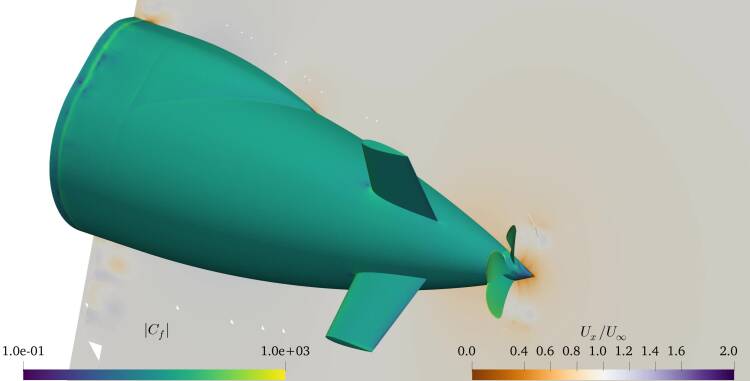




April 2023, no. 135
Create a MARIN account to stay updated
Report
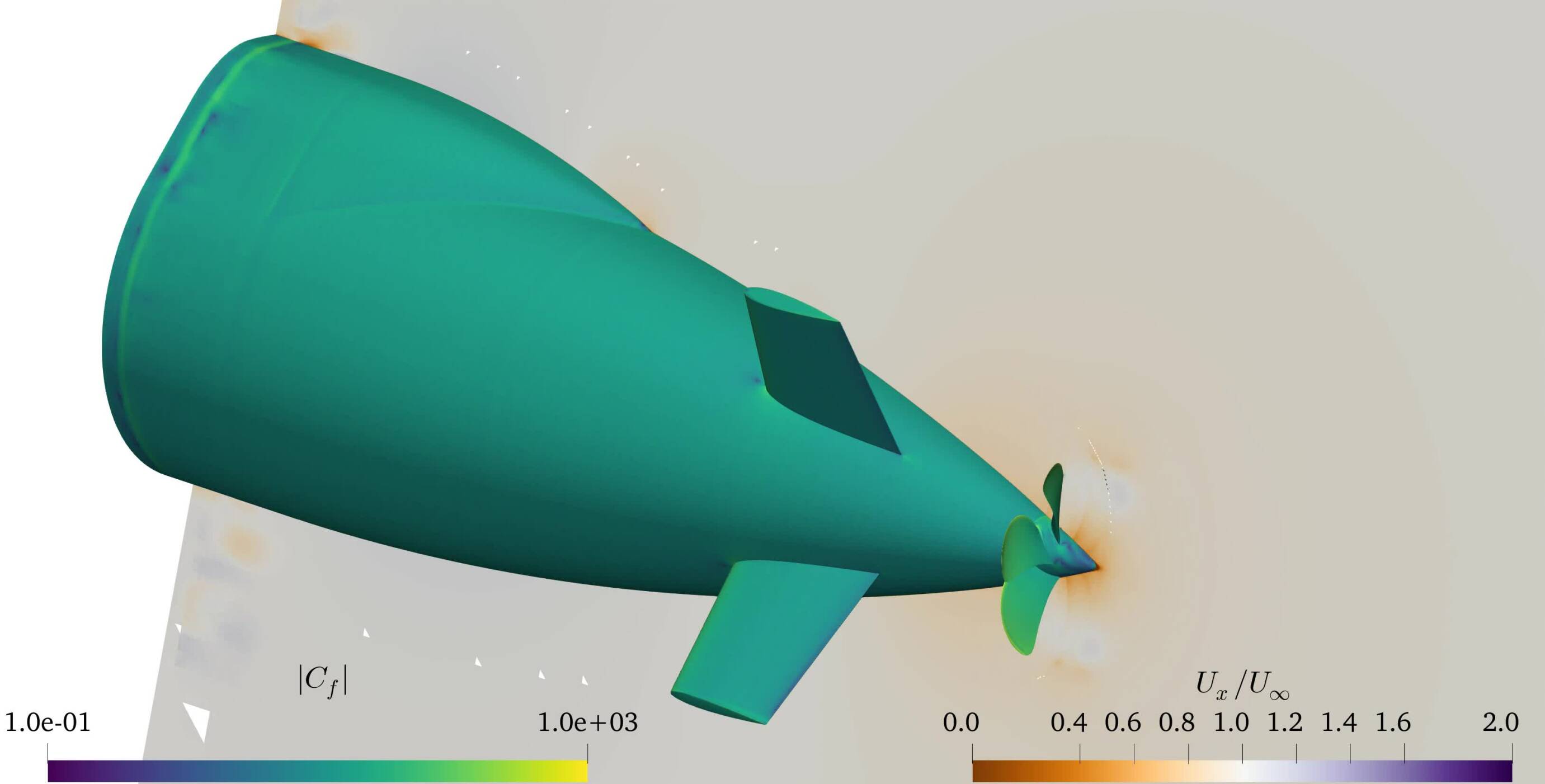
MARIN’s CFD Development Team and its partners further advance the renowned viscous flow code
The renowned viscous flow code ReFRESCO, developed by MARIN and various international collaborators, has achieved an important milestone, as the latest version 2023.1 is unveiled.
ReFRESCO is used in many research and consultancy projects, calculating forces on ships and offshore and renewable energy structures in combined wind, wave and current conditions. In addition to environmental forces, propulsors can be computed from actuator disc models via boundary element methods to full viscous flow simulations. ReFRESCO has many other capabilities such as moving bodies, turbulence models, free-surface, roughness and transition models, to name but a few.
ReFRESCO has been developed since 2005 by the CFD Development Team at MARIN and in various international collaborations. The longest-running collaboration is with the Instituto Superior Técnico in Lisbon. The latest addition coming from Portugal is a result of the work of Joao Muralha, who implemented compressibility in the solver that enables the calculation of compressible flow phenomena. One example is the fundamental studies performed at the MARIN Atmosphere facility, where overturning and collapsing waves onto a fixed object are studied in great detail.
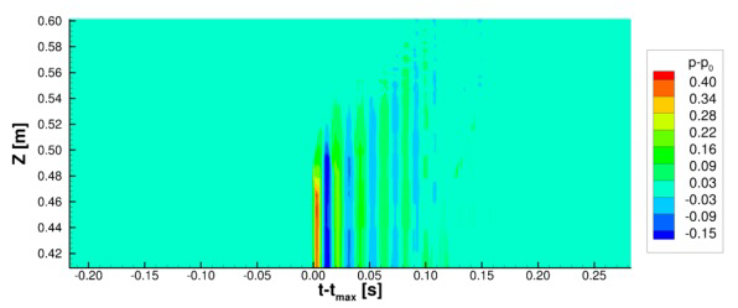
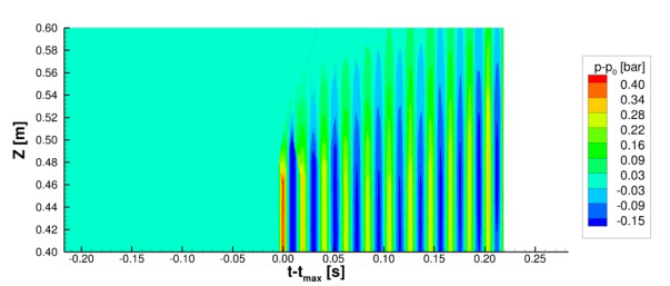
Above: Experimental pressure signature of wave impact with gas pocket measured in the Atmosphere facility. An overturning wave impacts a vertical plate instrumented with pressure sensors. The pressure signal in time and space shows that the trapped gas pocket pulsates a number of times before the phenomenon is damped.
Below: Computational pressure signature of wave impact with gas pocket, calculated with the ReFRESCO compressibile solver. The pulsating character is reproduced very well, but the damping much less.

Overset grid setup of propeller-rudder test case.

Iso-surface of Q-criterion highlighting vortices coming off the rotating propeller.
Meanwhile, Sebastien Lemaire (University of Southampton, in collaboration with BlueOASIS Portugal), finished his PhD in 2022 on the topic of overset grids. Instead of using a single grid, overset grids provide optimised grids for each part of the simulation, and enable complex motions that were until now impossible to simulate. The connection between the grids is made by interpolating the simulated fields such as velocity, pressure and turbulent quantities between the various overlapping grids. Sebastien has concluded that the interpolation method used has a big impact on the final results, with higher order interpolation schemes giving better results in general.

As well as these long-running PhD research projects, of which two are presented above, MARIN’s CFD Development Team dedicates its time to developing ReFRESCO. To highlight just one topic: Over the last decade significant effort has been given to free surface modelling, which involves the simulation of floating bodies with water and air, and the wavy surface in between. The latest issue that was addressed was numerical ventilation, a well-known problem in the maritime CFD community, where there is no scientific agreement on why it is happening, or what can solve it. Numerical ventilation – the non-physical trapping of a very thin layer of air along the hull - usually only occurs in a complex flow around a ship’s hull for example.
By studying a simplified case, and carefully observing when numerical ventilation is triggered, it was found that the cause must be sought in the algebraic volume-of-fluid transport model, and not in the numerical details. This also led to the development of a correction, where a sink term is added to the model that can suppress numerical ventilation in real-world cases.
This year, the team is focusing on scale-resolved simulations, interaction with other packages for non-linear potential flow for waves and aerodynamics, and non-linear structural simulations with finite elements.
The animation shows an unsteady simulation of the BB-2 submarine model with a rotating propeller carried out using scale-resolving simulations. It depicts iso-contours of instantaneous wall-shear stress on the submarine body and non-dimensional axial velocity on the centreplane of the numerical domain. Only the aft part of the geometry is resolved and the effect of the turbulent boundary layer on the upstream part of the hull is modelled using a combination of prescribed average inflow velocity and synthetic turbulence generation. Such a numerical setup facilitates a vast reduction in the number of grid cells that need to be used to model the full turbulent flow compared to simulating the complete propeller. This greatly reduces the cost of these simulations to the point where they can even be carried out in a commercial setting. Future applications will mostly revolve around noise and vibration predictions, as well as detailed propeller design benchmarking.
More info:
An efficient and accurate overset grid technique applied to maritime CFD, Sebastien Lemaire, 2023 (Doctoral Thesis)



April 2023, no. 135







An efficient and accurate overset grid technique applied to maritime CFD, Sebastien Lemaire, 2023 (Doctoral Thesis)
More info:
The animation shows an unsteady simulation of the BB-2 submarine model with a rotating propeller carried out using scale-resolving simulations. It depicts iso-contours of instantaneous wall-shear stress on the submarine body and non-dimensional axial velocity on the centreplane of the numerical domain. Only the aft part of the geometry is resolved and the effect of the turbulent boundary layer on the upstream part of the hull is modelled using a combination of prescribed average inflow velocity and synthetic turbulence generation. Such a numerical setup facilitates a vast reduction in the number of grid cells that need to be used to model the full turbulent flow compared to simulating the complete propeller. This greatly reduces the cost of these simulations to the point where they can even be carried out in a commercial setting. Future applications will mostly revolve around noise and vibration predictions, as well as detailed propeller design benchmarking.
By studying a simplified case, and carefully observing when numerical ventilation is triggered, it was found that the cause must be sought in the algebraic volume-of-fluid transport model, and not in the numerical details. This also led to the development of a correction, where a sink term is added to the model that can suppress numerical ventilation in real-world cases.
This year, the team is focusing on scale-resolved simulations, interaction with other packages for non-linear potential flow for waves and aerodynamics, and non-linear structural simulations with finite elements.
As well as these long-running PhD research projects, of which two are presented above, MARIN’s CFD Development Team dedicates its time to developing ReFRESCO. To highlight just one topic: Over the last decade significant effort has been given to free surface modelling, which involves the simulation of floating bodies with water and air, and the wavy surface in between. The latest issue that was addressed was numerical ventilation, a well-known problem in the maritime CFD community, where there is no scientific agreement on why it is happening, or what can solve it. Numerical ventilation – the non-physical trapping of a very thin layer of air along the hull - usually only occurs in a complex flow around a ship’s hull for example.

Meanwhile, Sebastien Lemaire (University of Southampton, in collaboration with BlueOASIS Portugal), finished his PhD in 2022 on the topic of overset grids. Instead of using a single grid, overset grids provide optimised grids for each part of the simulation, and enable complex motions that were until now impossible to simulate. The connection between the grids is made by interpolating the simulated fields such as velocity, pressure and turbulent quantities between the various overlapping grids. Sebastien has concluded that the interpolation method used has a big impact on the final results, with higher order interpolation schemes giving better results in general.
Iso-surface of Q-criterion highlighting vortices coming off the rotating propeller.

Overset grid setup of propeller-rudder test case.
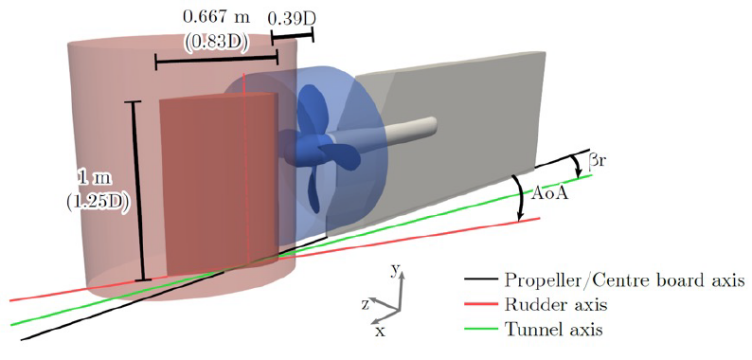
Above: Experimental pressure signature of wave impact with gas pocket measured in the Atmosphere facility. An overturning wave impacts a vertical plate instrumented with pressure sensors. The pressure signal in time and space shows that the trapped gas pocket pulsates a number of times before the phenomenon is damped.
Below: Computational pressure signature of wave impact with gas pocket, calculated with the ReFRESCO compressibile solver. The pulsating character is reproduced very well, but the damping much less.
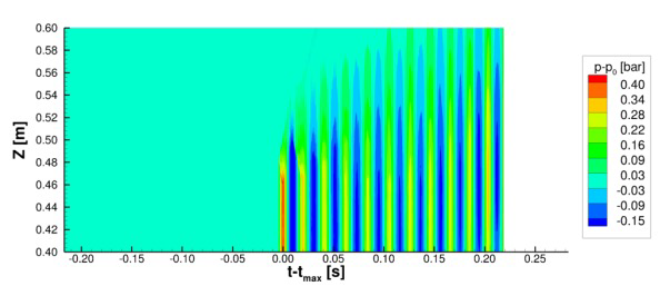
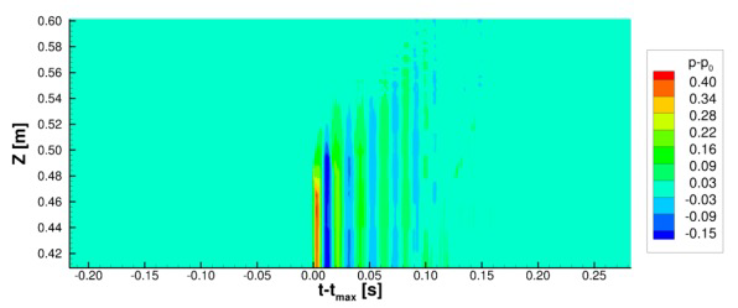
The renowned viscous flow code ReFRESCO, developed by MARIN and various international collaborators, has achieved an important milestone, as the latest version 2023.1 is unveiled.
ReFRESCO is used in many research and consultancy projects, calculating forces on ships and offshore and renewable energy structures in combined wind, wave and current conditions. In addition to environmental forces, propulsors can be computed from actuator disc models via boundary element methods to full viscous flow simulations. ReFRESCO has many other capabilities such as moving bodies, turbulence models, free-surface, roughness and transition models, to name but a few.
ReFRESCO has been developed since 2005 by the CFD Development Team at MARIN and in various international collaborations. The longest-running collaboration is with the Instituto Superior Técnico in Lisbon. The latest addition coming from Portugal is a result of the work of Joao Muralha, who implemented compressibility in the solver that enables the calculation of compressible flow phenomena. One example is the fundamental studies performed at the MARIN Atmosphere facility, where overturning and collapsing waves onto a fixed object are studied in great detail.
MARIN’s CFD Development Team and its partners further advance the renowned viscous flow code

Report
